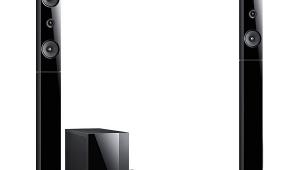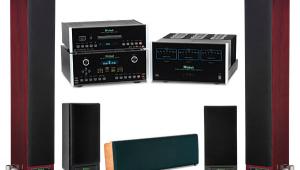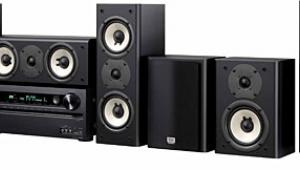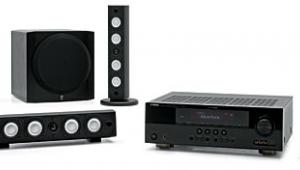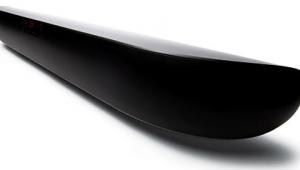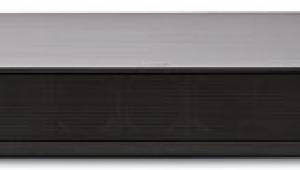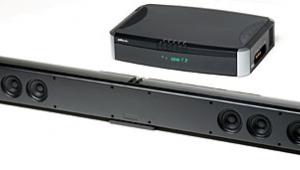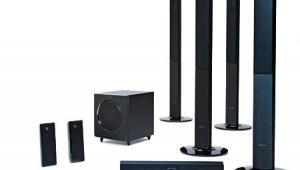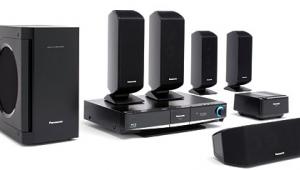Sequence Strata Speaker System, Primare DVD26 DVD Player & SPA21 Surround Processor/Amplifier
Whether by nature or nurture, I'm a speaker guy. I'm more captivated by speakers than any of the associated electronics in a home theater system. As a result of this singular infatuation, I've always believed, as a general rule of thumb, that you should allocate at least half of the total cost of the audio portion of your system to the speakers. I don't know why the math seems to work out that way, but, in my mind, it just does. So what am I to make of a system in which the Primare electronics cost twice as much as the Sequence/REL speaker package?
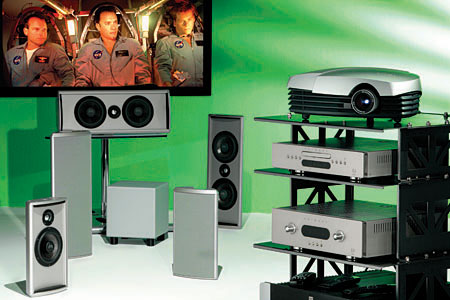
The skeptic in me says that I should stack it in the corner and move on to that $199 home-theater-in-a-blister-pack system I've been dying to crack open. Curiosity, however, makes me open the pocketknife, slice the packing tape, and hear a whooshing sound as my inflated speakers-over-all belief gradually loses the hot air I've puffed into it. Yes, thanks to Primare's SPA21 sound-processing integrated amplifier and DVD26 DVD player, my heart is now filled with a lust for power supplies, preamp circuitry, and DSP algorithms.
Higher-end electronics (as well as cars, beer, and cigars) elicit an array of opinions and biases (mental, not electronic). Take the tubes-versus-solid-state debate or, closer to home, the stereo-versus-multichannel fracas, for example. Whether it's due to Scandinavian stubbornness, too much fish in their diet, or an outlook unshackled by common preconceptions, Primare doesn't defend any particular turf (aside from excellent sound quality). Their attitude is to ignore limiting mental boundaries and do their own pragmatic thing. If an off-the-shelf part or technology performs well, they use it. If they can't find a solution they deem acceptable—as with DSP circuitry—they design their own. I suppose you could call them dogmatic in two other respects: simplicity of operation and elegance in exterior design. It's hard to find fault with that combination of engineering philosophies, especially when the results are so good.
Unfortunately, sweat is never as exciting as glitter. There's no secret sauce or proprietary patents that would be fun to fawn over (at least nothing Primare would tell me about)—only an eloquent execution of solid, basic design philosophy, such as the emphasis on heavy-duty power supplies. When you starve a circuit or internal component of electrical power, the result is anemic performance—especially when the signal or load is most demanding. To avoid this, Primare designs and builds their products around mondo (that's a highly technical term) power supplies. It doesn't take a roomful of North Korean nuclear scientists to figure this out, but too many companies skimp on power-supply size and quality because it generally adds expense and weight. (Think shipping costs.)
The signal path is another important design area. I had mistakenly thought that Primare's attractively offset front panels were purely for appearance's sake. It turns out that, in addition to being beautiful, the offset front panel is actually a separate section that contains control circuitry—a design that helps eliminate interference within the unit itself.
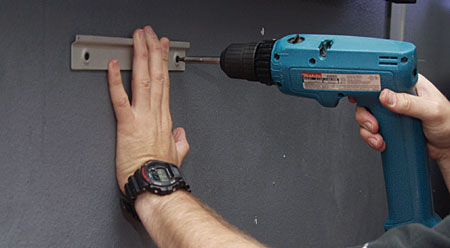
Such attention to detail pays off. In the case of the DVD26, Primare's "basic" DVD player, the result is detailed and splendid audio and video. Playing a part in this is the use of separate windings in the power supply's transformer for the audio, video, digital, and mechanical sections (plus extremely high-quality video and audio DACs). Take a gorgeous DVD, like Apollo 13, and you'll be astonished at how good analog video can look. In my opinion, the only complaint you'll ever have about the DVD26 is the fact that it doesn't play SACDs or DVD-Audio discs. Primare is quick to point out that their $4,000 top-of-the-line DVD30 universal player, which shares many of the DVD26's fundamentals—including the basic transport—is available for those who want it all.
You don't see multichannel integrated amplifiers with built-in processors every day, but the Primare SPA21's remarkable performance will have you so enthralled with your music and movie collection that you won't have any time left over to notice the absence of an FM tuner. Primare's straightforward design approach results in an integrated amp/processor with a sonic character that I can best describe as having no real character at all. Of the many ways in which the SPA21 will garner your affection, the overall balance and transparency of sound is the most significant. If you love movies as well as music, you'll applaud the fact that Primare treats film sound not as the bastard child of the audio world but as an esteemed colleague of two-channel. Primare lavished time and engineering resources on the DSP section, developing their own proprietary circuitry. It produces a soundfield that I'd say is not so much stunning as it is smoothly coherent. This is important if your flick fancies run the gamut from movies such as Richard III (1995), Star Wars: Episode I—The Phantom Menace, and White Noise. These are movies in which the soundtracks are integral to the experience, but each has entirely different intended effects on the audience. The SPA21 handled all of these titles without prejudice or favoritism.
The SPA21 doesn't shortchange video, either, due to a design that keeps the signal pristine from input to buffered output. There are composite, S-video, and component inputs with 125-megahertz-rated bandwidth-switching capability for two component HD inputs. The beefed-up power supply provides the video section with benefits similar to those in the audio portion of the SPA21, resulting in a stable, clean signal that helps make any monitor look its best.
Perhaps the main allure of Primare's gear is that high performance, intuitively easy operation, and beautiful aesthetics are so completely intertwined. Primare doesn't sacrifice one for another, which makes the SPA21 a dream to use, as well as to listen to. The simplicity of daily operation, however, does come at the cost of an initial setup that's more involved than that of most preamps or receivers. It's not complicated, but it does require a bit of time and a small amount of thought. The reason is that the SPA21 is so configurable, with 15 user-selectable inputs. You can assign each one to a different source, or you can assign them all to the same source—and you can program each input with its own particular DSP parameters. In the case of the most simple of systems—the SPA21 with a single source, the DVD26—you can create up to 15 virtual sources. Input 1, for example, might be Dolby Digital decoding of a disc in the DVD26 connected via its S-video and optical digital outputs. Input 2 could be DTS decoding with the player connected using the component video and coaxial digital outputs. You could configure Input 3 with your favorite processing settings for older, mono movies, while you might configure Input 4 to handle Dolby Pro Logic II decoding. The short story is that, instead of hassling with surround-setting adjustments, all you do is select the appropriate input that's preset for the source material.
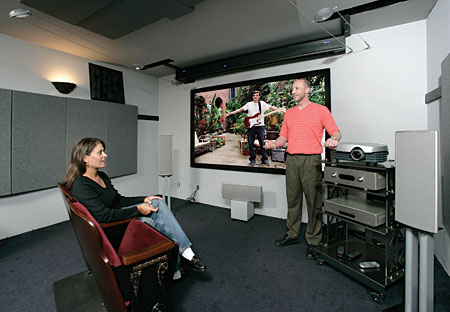
There are a few things I don't like about the SPA21/DVD26 combo. The included (identical) remotes are very basic, so you'll want to get a good universal remote. The SPA21 doesn't upconvert video signals—it only transcodes S-video to composite—so you might have to run multiple video cables to, and switch inputs on, your TV depending on your source components. The CineVERSUM 60 front projector I used automatically scanned its inputs for a signal, so it was a moot point for me. Beyond that, the Primare gear was truly splendid.
It's a Bird; It's a Plane—Aw, Crap, It's an On-Wall Speaker. . .
Oh, joy. Just when you thought your wall couldn't get any more crowded with thin speakers designed to snuggle up next to a flat-panel TV, here's another Johnny-come-lately to the "looks great, less thrilling" slim-speaker party. It's enough to make a grown man's ears cry—if they could cry, anyway. And who the heck is Sequence?
Sequence, as it turns out, is a Johnny-come-early who's been designing and building on-wall speakers for 15 years. They didn't start slapping speakers on walls because of a psychic sense of future popularity, though. They like designing speakers specifically for use on a wall because it's quite liberating from an engineering point of view. (The thought of liberated British speaker engineers casting aside their slide rules and calculators whilst running free in a field of daisies brings a tear to my eye.) In other words, if you know that a particular speaker is going to rest its weary back against one of your room's primary boundaries (or very close to it, at least), you can specifically tailor your design to take advantage of it.
But how do you get the best sound out of a speaker with an extruded-aluminum cabinet that's a mere 3.6 inches deep? As with all three Sequence models—the Strata 2000 loudspeaker, the Strata 2000C center channel, and the Strata 1000 surround—one solution is to use 6.5-inch bass/midrange drivers (a pair in the 2000 series and one in the smaller 1000 model) utilizing an inverted magnet structure in which the magnets hang on the front side of the cone rather than the rear. With the magnets out front, Sequence can use a larger, more powerful magnet while keeping the speaker cabinet as small as possible.
For wall mounting, the Strata 2000 and Strata 1000 slide over a sturdy, easy-to-mount L-shaped bracket, while the horizontal Strata 2000C hangs on a tongue-and-groove-style bracket. Not a hole-in-the-wall type of person? Sequence also offers matching floor stands designed for use as close to the wall as possible. I used a pair of Strata 2000s and a Strata 2000C on my front wall, plus a pair of Strata 1000s on the rear wall. The Strata 2000's bass response is surprisingly good, considering its size, but you're going to want a subwoofer, such as the REL Q108, in order to get the deepest impact with movies. The Q108 is a great choice for use with the Strata system because it's a nice match visually, being both small and silver. More importantly, the ability to tailor the Q108's crossover point to slide in under the response of the on-walls, as well as the simultaneous, independent control of the high- and low-level bass inputs lets it perform as a foundation for the system.
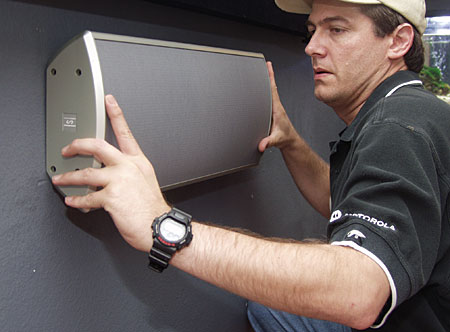
With wall-mounted speakers, there's no need to determine how far away from the back wall you'll need to place them for best performance, so setting up the Strata system is relatively easy. As with the Primare electronics, the Sequence/REL combination's sound is neutral and well balanced, with an ability to resolve fine detail that makes these speakers especially suited to small-theater-room movie watching. The combo also has plenty of authority when playing anything from Joe Cocker singing "Chain of Fools" (Heart & Soul) to the Persuasions performing "Even Better Than the Real Thing" (The Persuasions Sing U2). And they do Rush's "Fly by Night" as well as the multilayered instrumentation of Larry Chernicoff's "Sailor and Siren" (October).
My time with the Sequences and the REL made me realize that I haven't lost my love of speakers. They're just as intriguing and as magical for me as ever. But I have to give thanks to the Primare gear for expanding my horizons and showing me the error of my transducer-only ways.
It's a Vision Thing
I was a bit miffed when the folks at Sumiko, the company that markets the Primare and Sequence brands in this country, sent along a CineVERSUM 60 front projector (and cajoled Stewart Filmscreen into loaning me a 70-inch-wide StudioTek 130 screen) to use with the system. CineVERSUM, for those who don't know (which is probably just about all of you), is a line of front projectors with Barco engineering under the hood. The impressive technological pedigree wasn't what bothered me. It was the 1,024-by-576, 16:9 DLP chip inside.
They're trying to impress me with enhanced definition? Do they think I'm an idiot? Evidently, I am an idiot, because I was thoroughly impressed with the color saturation and detail that the CV60 produced on the StudioTek 130 screen after Dave Ellington from Sumiko carefully calibrated the projector. The projector is certainly no blowtorch when it comes to light output; but, on the 70-inch screen in a moderately darkened room, the image was gorgeous. Sumiko says one of the reasons for the spectacular color is the use of a lamp that's as near 6500 K before adjustments as any on the market.
And how about the 1,024-by-576 business? Well, with the projector's exceptional lens system, availability of critical calibration adjustments, and internal circuitry that works so well at scaling high definition to 576p, it's dang difficult to convince yourself that you're not watching HD. So call me stupid (lots of other people do), but I say, with the CineVERSUM 60, the eyes have it.
CineVERSUM 60 powered by Barco, $7,995
